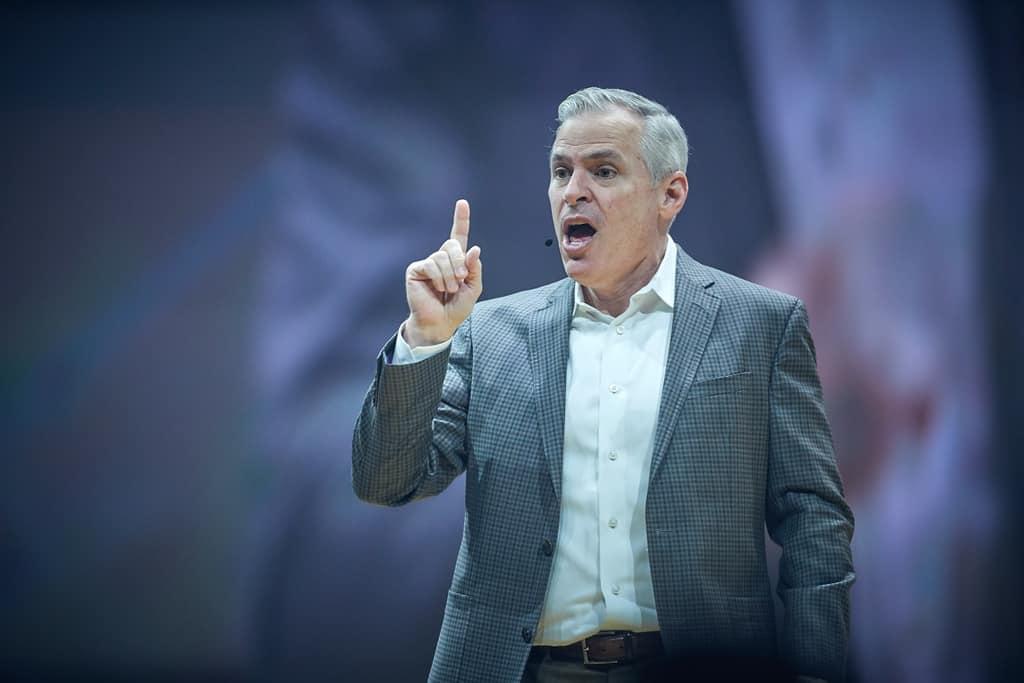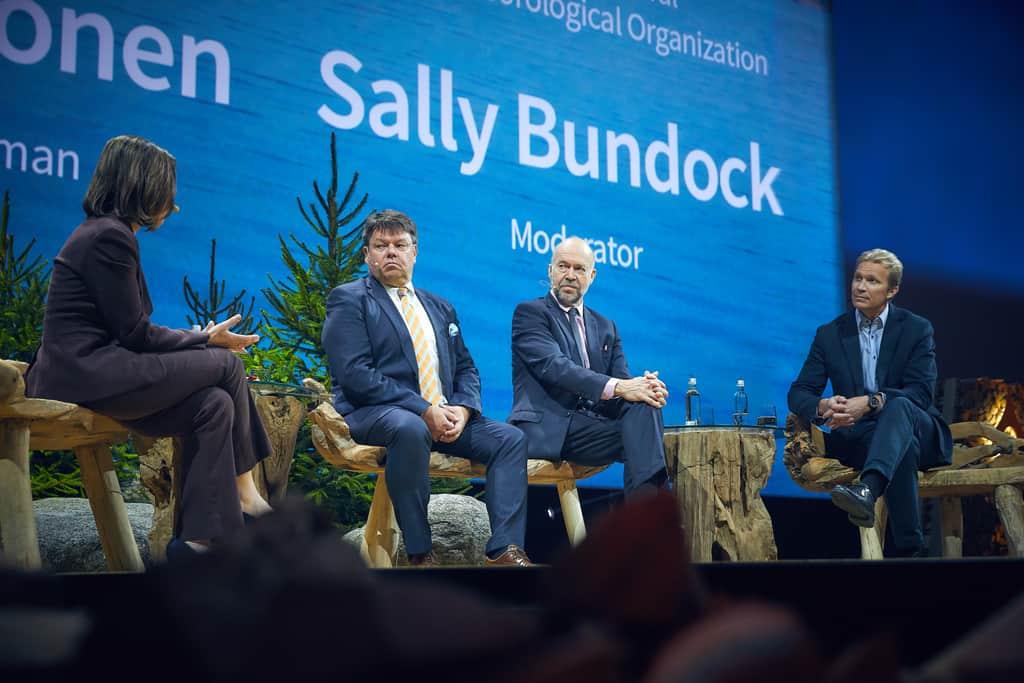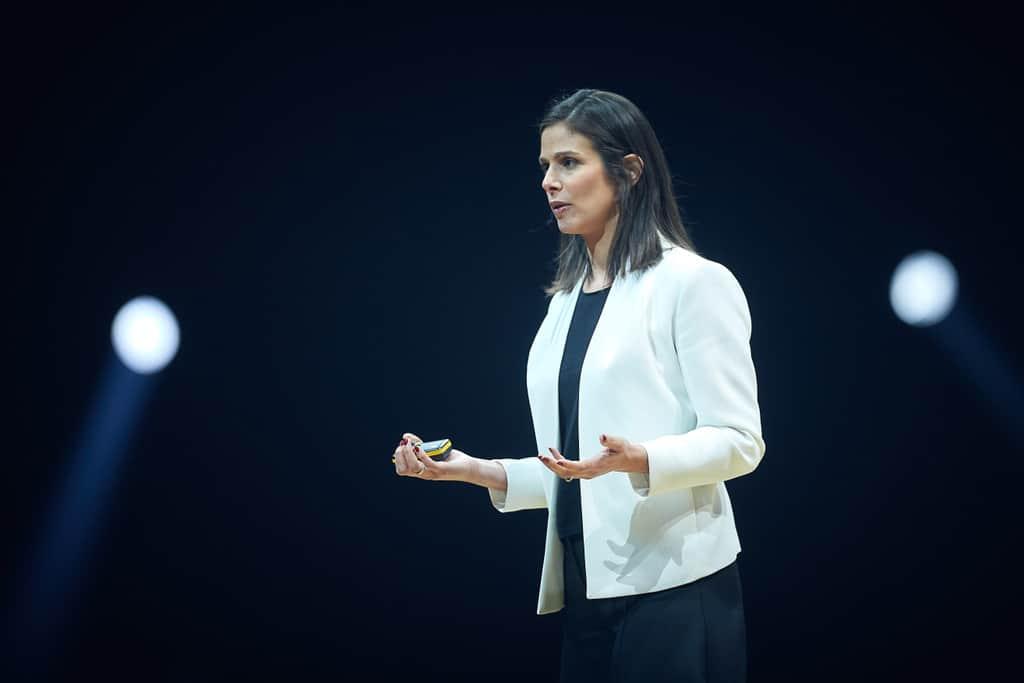4Feb2018
Patrick Lencioni, the author of 11 best-selling business books, opens his talk by telling the Nordic Business Forum audience that he believes the greatest competitive advantage in the world is available to any organization that wants it.
Lencioni says a successful organization has to be two things: smart and healthy. He also points out that “leaders pay too much attention to the former and not enough on the latter.”
According to Lencioni, a smart company is good at strategy, marketing, finance, and technology. In most companies, these subjects get 95% of the leader’s attention. A healthy company has minimal politics and confusion, high morale and productivity, and very low employee turnover.
One reason why the healthy aspects are overlooked is that most leaders find it easier to look for answers on the smart spectrum. These subjects can be read about, studied, measured, and quantified. However, Lencioni has found that “most organizations are smart and everyone knows how to do their jobs.”
He’s convinced that the area ripe for the greatest competitive advantage and transformation is the healthy side because the average company is plagued by politics and confusion. The best companies in the world figure out how to be healthy.
The four disciplines of a healthy organization
Lencioni told Nordic Business Forum that there are four actions that define healthy organizations.
1) They build a cohesive leadership team.
All healthy organizations must have a strongly united team in charge, all individually committed to pursuing a common goal.
2) They create clarity.
Healthy organizations also have complete clarity amongst those leaders. The heads of a team, department, and/or organization must be both behaviorally and intellectually aligned.
3) They over-communicate clarity.
People have to hear something seven times on average before they believe it, but most leaders don’t like to over-communicate. Healthy organizations aren’t afraid to repeatedly reinforce ideas.
4) They reinforce clarity.
Leaders need to build the right amount of structure in human systems to support it. They institutionalize their culture without bureaucratizing it.
To accomplish these disciplines, Lencioni asserts that leaders need to master five behaviors.
Trust
“If you walk away with just one thing, it’s this: Build vulnerability-based trust in your team, it will change everything,” Lencioni urges, and makes a distinction between predictive and vulnerability-based trust on teams. Predictive trust is where two people, who have known each other for some time, can predict each other’s behavior and reactions in a given situation. The type of trust that teams really need is vulnerability-based trust. This is when people are comfortable enough to say: “I don’t know the answer, I need help, I screwed up, and I’m sorry.” When people can be emotionally transparent, it changes everything, Lencioni explains. The best way to understand the power of vulnerability is to think about teams that don’t have it.
Lencioni shares an example of a meeting he observed. At this meeting, a woman from the marketing department shared her thoughts, but no one on her team responded to her ideas. After the meeting, Lencioni asked the team members why that happened. They told him that the woman never admitted fault and felt she always had the best answers, so they had decided to stop engaging with her. A week later, Lencioni held a two day offsite with the team where he talked about trust and vulnerability. At dinner that evening, the woman from marketing stood up and announced that she had been married for ten years and had just started trusting her husband so she wouldn’t be trusting anyone on her team soon. Lencioni worked with the woman on her fundamental trust issues for months to no avail. Eventually, the CEO let her go. At the first meeting without her, the dynamics of the team changed so much that it seemed like every member was replaced. When there’s one person on the team that cannot be vulnerable, it spreads like a disease to the rest of the team.
Lencioni also explains how important it is for the leader to be an example. “The leader of the team has to go first. If the leader of a team can’t go first and be vulnerable, then he or she can’t ask anyone else to be vulnerable.”
He once worked with a CEO who was not a good leader although he was brilliant, intimidating, and famous. The CEO had his team do 360-degree feedback on him. After he got the unflattering results, he read them aloud to his team and then asked if the team members thought they were accurate. The team members denied the problems, so the CEO learned nothing from the exercise. The CEO showed no vulnerability and did not admit his weaknesses, which prevented his team from being open with him or each other.
Lencioni says that it’s a common misconception that leaders aren’t supposed to let people see them sweat. He says if you’re a leader, your people will see you sweating before you realize it yourself. The best leaders are the ones who point out their struggles. This gives them credibility; people don’t expect leaders to be perfect, but they do expect them to be honest.
Lencioni spends more time talking about trust than any of the other dysfunctions of a team because he believes if a team can build trust, they can overcome any other issue.
Conflict
“Conflict without trust is just politics, but conflict with trust is the pursuit of truth or the best possible answer,” Lencioni explains and starts to talk about the second foundational issue of a winning team. He tells the audience that productive, ideological conflict is a good thing. This is conflict around ideas and decisions. Also, it will look different from culture to culture. Lencioni illustrates that with an example of working with a culturally Japanese team: If someone shares an idea and everyone nods their heads, it means they don’t like the idea. If they really hate the idea, they will suck air through their teeth. If a person doesn’t know the culture, they may think that their idea was well received when it was not.
Lencioni reveals that no matter the culture, you have to know that the leaders on your team are not holding back their opinions and will speak up when something isn’t right. When people trust each other, they argue because they want to make the right decision.
He shares an anecdote about his marriage and how arguing is beneficial when trust is in place. His wife’s sister married his former roommate, and they got along well but divorced after a short time. His former brother-in-law went to therapy and realized that his marriage wasn’t good because they couldn’t argue. Lencioni and his wife had always argued, but it was from a place of mutual trust and respect. After 25 years of marriage, they can resolve a big argument in 25 minutes.
“If your team never argues then you’re probably not making the best possible decisions,” Lencioni states. Teams grow closer together when they argue, but the average company has very little conflict. Sometimes this is because executives don’t want to hurt people’s feelings. According to Lencioni, the problem with not wanting to hurt people’s feelings over disagreeing with an idea is that you end up creating a personal problem instead. When teams can’t disagree about issues, it will naturally become about the people involved. Good teams disagree and respect each other more in the process.
Commitment
“If people don’t weigh in, they’re not going to buy in,” Lencioni says as he starts to talk about commitment. When teams come to a consensus, it often means that the decision is made too late and is mutually disagreeable to everyone. He says that “it’s the job of the leader to make sure everyone weighs in and feels heard.” The leader is there to break the tie with a final decision. Waiting for a consensus does not allow a business to be nimble.
Lencioni points out that 99 times out of 100, a person will support a decision that they disagree with if they feel like their opinion was heard. People don’t need to get their way, but they do need to know that their way was heard and considered.
Accountability
The fourth element is accountability, and, according to Lencioni, “the best form of accountability is peer pressure”. He considers accountability to be the single biggest problem on teams. People do not like to keep each other accountable.
He shares an example of a hockey team. When someone on the team makes a mistake, they don’t apologize to the coach. They apologize to each other. On the best teams, a person doesn’t want to let down their teammate.
Lencioni believes the only way to create a culture where peers hold each other accountable is to show that the leader models this behavior. The leader has to be the ultimate source of holding people accountable. The best leaders will hold people accountable for both numbers and behavioral issues.
Results
“The mark of a great team is that it wins. Not every time, but most of the time.” Lencioni concludes that teamwork is about results, but sometimes people only care about their areas of responsibility. He says that most people won’t tell you outright that they don’t care about the team. The leader has to be sure that everyone on the team is focused on the overall results of the organization.
For Lencioni, the best leaders are not the ones who are famous or in the biggest companies. The best leaders are achieving results by being vulnerable, using trust, encouraging conflict, getting buy-in, and holding their people accountable. All of these factors combined give a team a competitive advantage.
This article is a part of the Executive Summary of Nordic Business Forum 2017. Get your digital copy of the summary from the link below.


